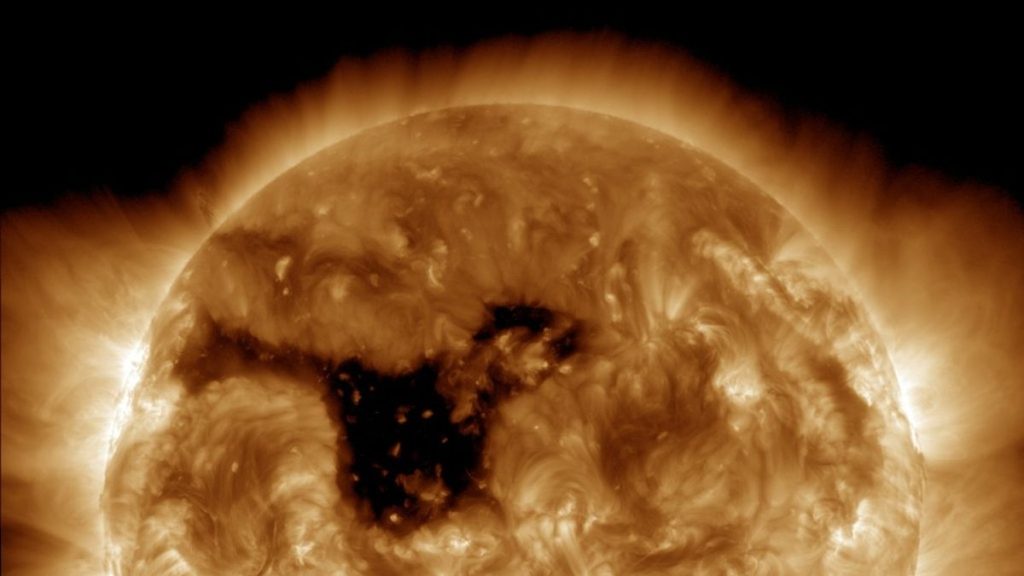Gigantic 500,000-mile ‘hole’ in the sun’s atmosphere aims aurora-sparking solar wind at Earth (photo) – Livescience.com

The gigantic coronal hole is blasting high-speed solar wind toward Earth, potentially igniting vibrant auroras and minor geomagnetic activity on Jan. 31. and Feb. 1.
When you purchase through links on our site, we may earn an affiliate commission. Here’s how it works.
Keep up with current northern lights forecasts and geomagnetic storm warnings with our aurora forecast live blog.A massive 500,000-mile-wide (800,000-kilometer) coronal hole in the sun’s atmosphere is unleashing a stream of fast-moving solar wind toward Earth, potentially supercharging auroras on Jan. 31 and Feb. 1.Coronal holes are areas where the sun’s magnetic field opens up, allowing solar wind to flow freely into space, according to SpaceWeather.com. In ultraviolet images, these regions appear darker because they lack the hot, glowing gases usually confined by magnetic fields, as the plasma escapes outward instead.The solar wind escaping from this coronal hole — the diameter of which measures over 62 times that of the diameter of Earth — is moving at speeds of more than 310 miles per second (500 kilometers per second). This flow is expected to reach Earth by Jan. 31 and Feb. 1, where it could spark minor (G1) geomagnetic storm conditions. While these storms are not severe, they can intensify auroral displays, creating vibrant northern and southern lights at higher latitudes. For an up-to-date breakdown of geomagnetic activity over the next 3 days, check out NOAA’s SWPC 3-day forecast. NOAA classifies geomagnetic storms using a G-scale, which ranks their intensity from G1 (minor) to G5 (extreme). The recent geomagnetic storm watch NOAA issued is rated as a G1.Auroras occur when solar wind interacts with Earth’s magnetic field. The charged particles from the sun collide with gases in the upper atmosphere, such as oxygen and nitrogen, transferring energy to them. This energy is released as light, producing the colorful displays seen in the night sky. The stronger the solar wind, the more dynamic and widespread the auroras can become.Though G1 conditions are possible for Jan. 31 and Feb. 1, remember that space weather is unpredictable and difficult to forecast, much like Earth’s weather. Even though geomagnetic storm warnings at this level are not uncommon, they can occasionally amount to nothing.To stay updated on space weather and know the best times and places to catch auroras, consider using a space weather app tailored to your location. One app I recommend is “My Aurora Forecast & Alerts,” available on both iOS and Android. Another great tool is the “Space Weather Live” app on iOS and Android which offers more in-depth insights into current space weather conditions and their potential for aurora activity.Editor’s note: This article was updated at 5:50 a.m. EST (10:50 GMT) on Jan. 31 to reflect the latest forecast, which now indicates that G1 geomagnetic storm conditions may be possible on both Jan. 31 and Feb. 1. Previously, activity was only expected on Jan. 31.Breaking space news, the latest updates on rocket launches, skywatching events and more!Join our Space Forums to keep talking space on the latest missions, night sky and more! And if you have a news tip, correction or comment, let us know at: community@space.com.Daisy Dobrijevic joined Space.com in February 2022 having previously worked for our sister publication All About Space magazine as a staff writer. Before joining us, Daisy completed an editorial internship with the BBC Sky at Night Magazine and worked at the National Space Centre in Leicester, U.K., where she enjoyed communicating space science to the public. In 2021, Daisy completed a PhD in plant physiology and also holds a Master’s in Environmental Science, she is currently based in Nottingham, U.K. Daisy is passionate about all things space, with a penchant for solar activity and space weather. She has a strong interest in astrotourism and loves nothing more than a good northern lights chase! SpaceX Starlink satellite sparks brilliant fireball as it falls from space over US (videos)Why Comet G3 (ATLAS) will be ‘remembered as the Great Comet of 2025’ (photos)How to see Venus snuggle up to a thin crescent moon this weekend
Space is part of Future US Inc, an international media group and leading digital publisher. Visit our corporate site.
©
Future US, Inc. Full 7th Floor, 130 West 42nd Street,
New York,
NY 10036.






